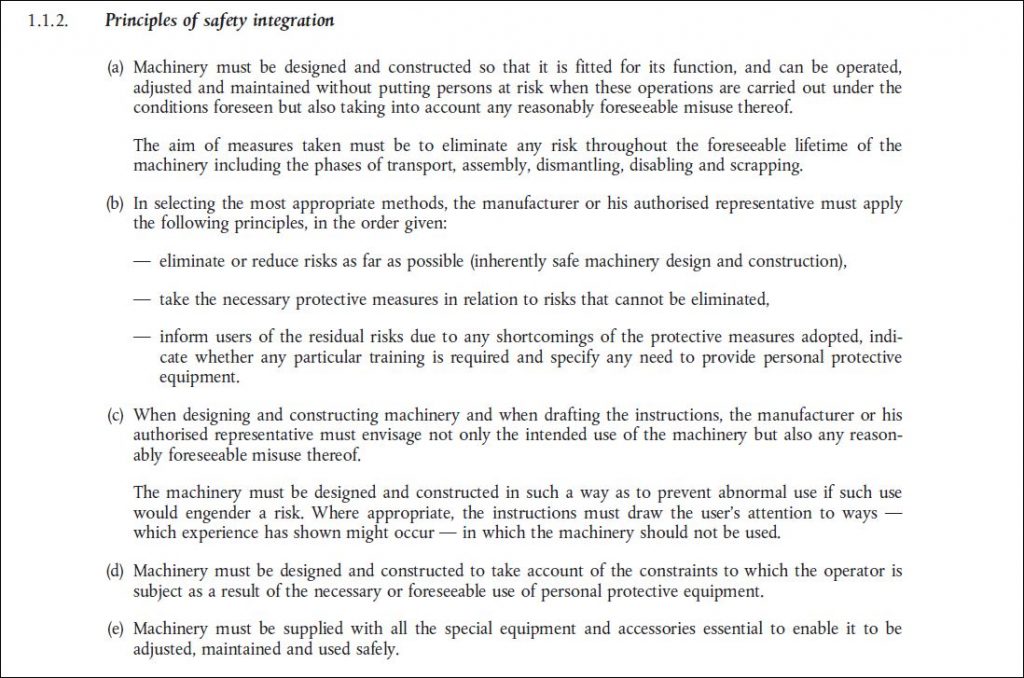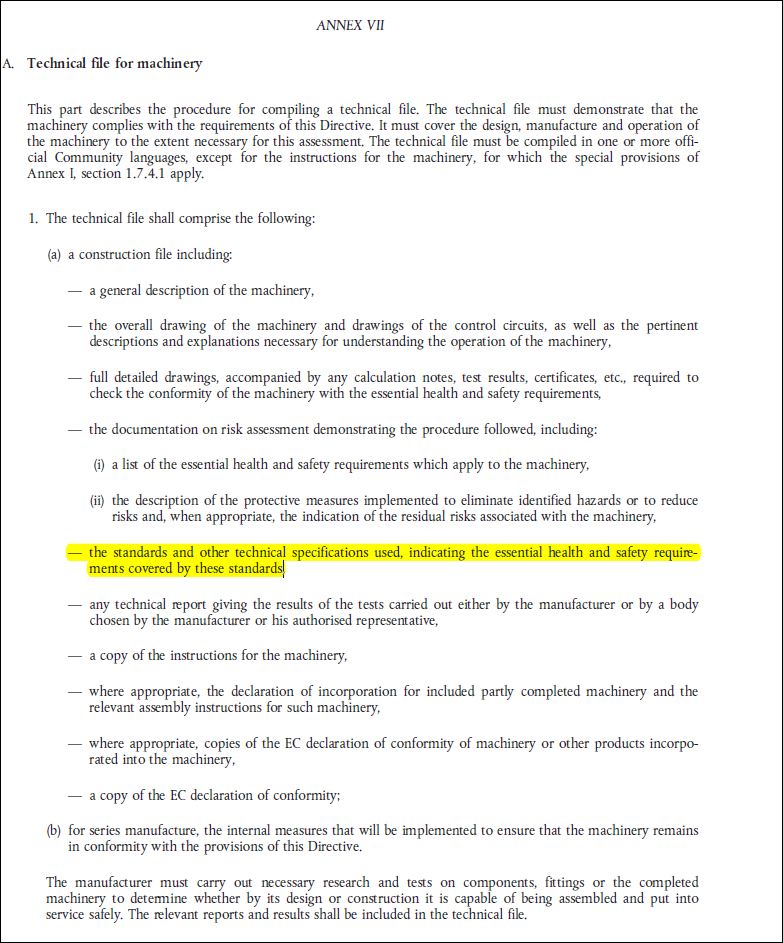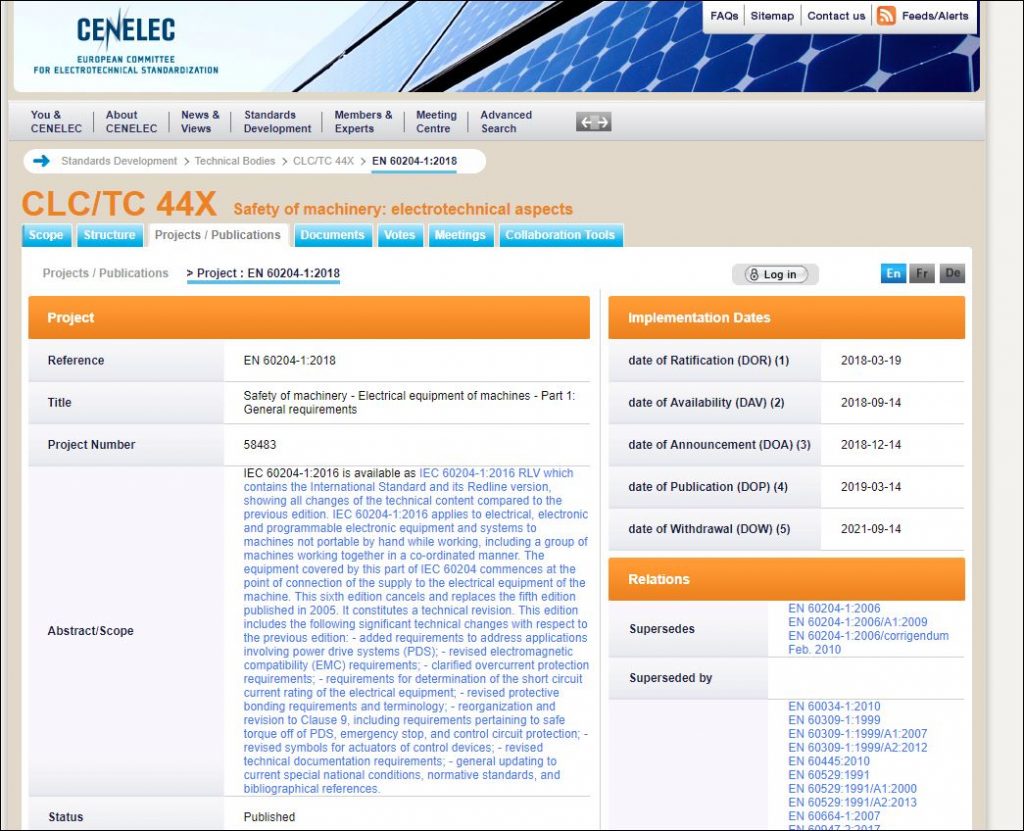The main electrical safety standard for machinery, EN 60204-1, was revised by CENELEC and published on September 14, 2018.
The currently harmonized version, EN 60204-1:2006+A1:2009, is still the officially recognized version. What does this mean? As a primer, I suggest reading an article we published about the role of harmonized standards and your CE marking projects two years ago.
EN 60204-1:2006+A1:2009 is, for now, the recognized version but eventually we will see the new standard on the official list published in the Official Journal of the EU.

Upon review of the new standard I noticed there are differences in some requirements as compared to the superseded versions. That is of course to be expected. However, what I found particularly interesting is the total revision and expounded Annex ZZ in the new version of the standard. See immediately below Annex ZZ from EN 60204-1:2006+A1:2009.

Annex ZZ from EN 60204-1:2006+A1:2009 references the specific Annex I EHSR’s (Essential Health and Safety Requirements) from the Machinery Directive 2006/42/EC. These are the only requirements in the Machinery Directive that can be evaluated against EN 60204-1.
This means, for instance, that the EHSR 1.2.4.1 can be satisfied by applying EN 60204-1 to the machine.

1.2.4.1 is listed in Annex ZZ of EN 60204-1. Therefore, compliance with that standard confers the presumption of conformity (this is explained in F2’s August 2016 article) to the machine for that EHSR, and all EHSR’s that are linked to EN 60204-1. For every 2006/42/EC, Annex I EHSR there must be a corresponding evaluation of the equipment, for that risk, against a harmonized standard or relevant clause from a harmonized standard. As an example, EN 61010-1 is a very comprehensive electrical safety standard that is harmonized to the Low Voltage Directive 2014/35/EU. Except for the sole 2006/42/EC Annex I EHSR 1.5.1 Electricity Supply, it cannot be used to validate compliance of machinery to any other 2006/42/EC EHSR. (Please see this article from 2016 for an understanding of the relationship between the Machinery Directive 2006/42/EC and the Low Voltage Directive 2014/35/EU).
Let’s look at another example. See Annex ZB from another very common harmonized Machinery Directive EN standard, EN ISO 13857:2008 – Safety of machinery – Safety distances to prevent hazard zones being reached by upper and lower limbs

Annex ZB from EN ISO 13857 lists three 2006/42/EC Annex I EHSR’s: 1.1.2, 1.3.7, & 1.4.1. Notice that none of these are listed in Annex ZZ of EN 60204-1. These EHSR’s are pasted below directly from the Machinery Directive.
2006/42/EC, Annex I, 1.1.2

2006/42/EC, Annex I, 1.3.7

2006/42/EC, Annex I, 1.4.1

Why is this important? A machine must be evaluated to EN ISO 12100:2010 in order to establish the applicable EHSR’s from 2006/42/EC, Annex I. There are many EHSR’s on that list and all of them may not be applicable to a particular machine. EN ISO 12100:2010 and the manufacturer’s risk assessment will tell a manufacturer exactly which of the EHSR’s are applicable.
But, you are not done at that step. The next step is to identify which harmonized EN standards can be used to evaluate the equipment to a particular EHSR or (as in the case of EN 60204-1) set of EHSR’s. For example, application of EN ISO 12100:2010 and the performance of a risk assessment may uncover a risk due to a moving transmission part. The manufacturer may then install a fixed guard over the part in order to protect operators and maintenance crews. This is referenced in clause 6.3.3.1.

Notice that EN ISO 12100:2010, 6.3.3.1 refers directly to ISO 13857. And EN ISO 13857 refers directly to 2006/42/EC, Annex I, 1.3.7. & 1.4.1.
Bringing this article back around to the new standard, EN 60204-1:2018, we refer to Annex ZZA, below.


It is interesting to note that the author(s) of the new standard were very specific in outlining the particular 2006/42/EC Annex I EHSR’s that are covered by this standard. A very helpful addition is direct reference to the particular clauses in Annex ZZA from EN 60204-1 to satisfy these EHSR’s. This is because entire standards are not required in order to prove compliance. To illustrate this, we refer to, The ‘Blue Guide’ on the implementation of EU product rules 2016, section 4.1.2.2, para 9:

The author(s) of EN 60204-1:2018 even made sure to exclude parts of specific EHSR’s. See below 2006/42/EC, Annex I, 1.7.4.2. with ‘u’ highlighted.

A point was made to specifically eliminate the airborne noise requirements in the instructions from EN 60204-1:2018. There are other EN standards that refer to making noise measurements and recording them in the instructions as pertains machinery, but that will have to wait for another article.
Summarizing all the above, i.e., “what does this mean?”
It means that for every applicable Machinery Directive 2006/42/EC, Annex I EHSR there must be a corresponding harmonized EN standard, or a clause from a harmonized EN standard, that is directly linked to that EHSR. Therefore, every EHSR that is identified as applicable to the machinery must be evaluated against a particular harmonized EN standard. This will, typically, lead to a number of EN standards being listed in the Technical File of the machinery, per 2006/42/EC, Annex V11 (A.) (1.) (a) (5th indent):

Your machinery does not benefit from the presumption of conformity without that.
Note that the requirement in Annex VII, (A.), (1.), (a.), (5th indent) is a different requirement than 2006/42/EC, Annex II (1.), (A.) (7.), (8.):

And, next, see Article 7 (2.) from the Machinery Directive:

The common practice is to indicate the main standards used on the declaration of conformity. Backing that up, in the Technical File, should be a chart against Annex I of the Machinery Directive. That chart should indicate every applicable Annex I EHSR, cross-referenced with the harmonized EN standard (or clause from the standard) to show it was evaluated. And, usually, in Annex ZZ of the standard you will find a list of Annex I EHSR’s that are linked to the particular standard. In this way it all fits together.
Want some help to understand the requirements of CE marking and your EU project? F2 Labs helps manufacturers across the globe every day with small and large products. We have experts who quickly determine what is applicable to the equipment, legally and technically.
We can be contacted via this link. We can be reached by phone at 877-405-1580 and are here to help you.
F2 Labs is here to help.

